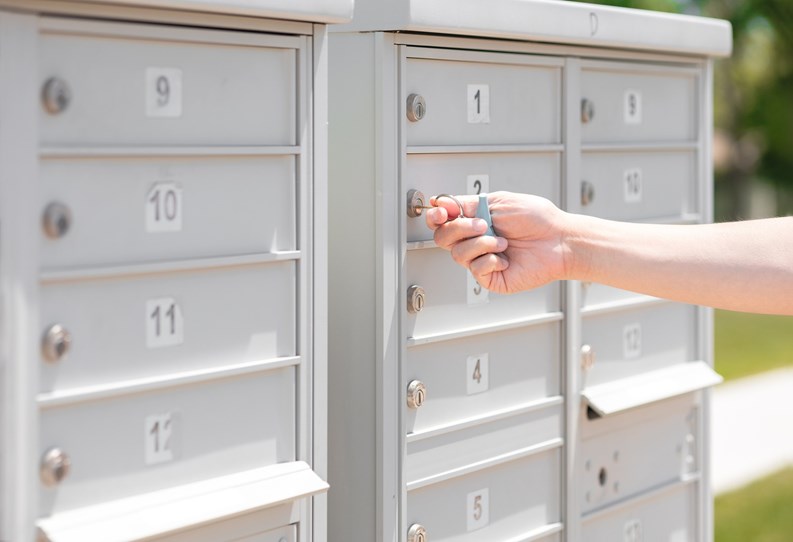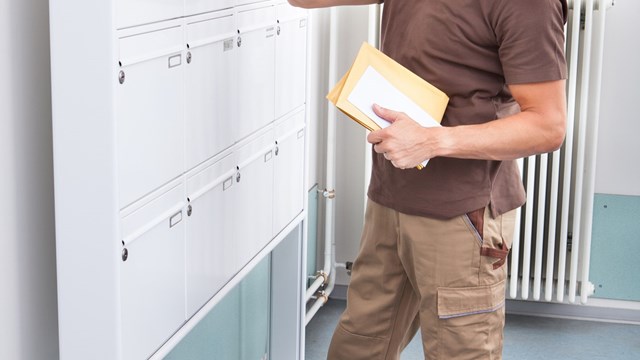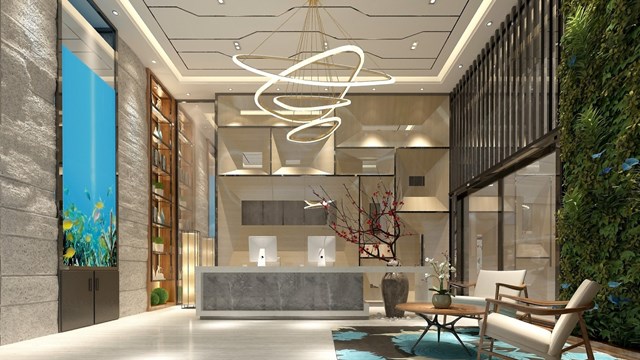Among the more mundane—yet vitally important—amenities in nearly every multifamily community is its mailbox and package delivery system. With the massive increase in deliveries in the Amazon Era, and especially post-pandemic, the design and integration of mail and package rooms have become more important than ever.
Mailbox Strategy
Mail delivery has been around longer than the United States itself. Instituted by Benjamin Franklin in 1775, it’s a basic service of government that most of us take for granted. The idea that you can drop a letter into a box at one end of the country and that it gets delivered to a faraway destination without a second thought—and usually in just a few days—is second nature, as easy as using a telephone.
When it comes to mail collection and delivery in the context of a multifamily building or HOA, the process is pretty straightforward—though the higher volume of letters, packages, and other items does require some strategy. The first element in designing a mailbox area actually lies with U.S. Postal Service (USPS) requirements. While over the years there have been many incarnations of mailboxes ranging in size and style, today the USPS has a standard for new mailboxes.
“It’s required by the postal code,” says Jonathan Baron, an interior designer and proprietor of Jonathan Baron Design, Inc., an interior design firm located in Manhattan. Baron has completed projects throughout the New York metro, including New Jersey. He is also on the board of directors of the U.S. Postal Service Consumer Council.
“If you remove existing mailboxes, you must use a postal code-approved replacement mailbox called a 4C,” Baron explains. “Basically, the 4C is 10 mailboxes stacked on top of each other, and for every 10 boxes, there’s a package locker attached.” Code-compliant 4C mailboxes must be a minimum of 12 inches wide, 3 inches high, and 15 inches deep. The parcel locker requirement is based on a 1:5 locker-to-mail compartment ratio. According to Baron, this requirement became effective in July 2020.
Baron goes on to say that with a 4C system, each mailbox holder has access to the package box. When mail is delivered and a package doesn’t fit into the resident’s individual box, the mail delivery person leaves a single-use key for the package box in the resident’s postbox, which the resident uses in tandem with their regular mailbox key to open the package locker and retrieve their delivery.
“From the point of view of aesthetics,” says Reggie Griffin, director of product coordination with Sygrove Associates Design Group, a New York-based design firm with many multifamily clients in New Jersey, “interior designers will try to combine federal requirements with the individual needs and necessities of the specific space. Proximity to the front door; an accessible but not ‘in-your-face’ comfortable space for postal staff, private deliverers, and residents to maneuver [in]; and a tidy, well-lit location are important considerations. Mailboxes must be in good repair without scratches, stickers, etc. In the event mailboxes are to be replaced, there are federal standards—such as providing a certain number of boxes below a certain height to meet [requirements of the] Americans with Disabilities Act.” There also may be municipal standards to adhere to, depending on where exactly the community is located, though Griffin does allow that these can be tough to enforce due to space constraints in more dense urban areas and the structural limitations of older buildings.
“Every property has its own unique architectural design,” says Baron. “When designing a mailbox and package storage space, I have to interpret the best aesthetic solution for each space and community. The cost of new mailboxes and of their installation may not always be the appropriate answer. I had a building in Harlem built at the turn of last century. They had the old mailboxes inset into the wall by 8 or 10 inches. They were in good condition, and it was a city-owned building. All I did there was put wooden molding around the mailboxes to enhance the turn-of-the-century aesthetic without getting involved in buying new mailboxes. The building also had plenty of room for package reception and a full-time super, which made the design easier conceptually as well.”
At another property in New Jersey, Baron was working on two huge mailbox areas located behind a wall. The problem was the sheer number of packages being delivered to the building. “We took out the mailboxes in one area and consolidated them in the other with new mailboxes, and turned the second area into a huge package reception location,” explains Baron. “It has two doors and, by fire code, metal frames and metal doors. That package area will be locked and secured. Although it’s a doorman building, doors can be locked, or they can choose to leave the doors unlocked.”
The Age of Amazon
But what happens when there are too many packages for the package box, or a package is simply too large for the package box? That’s where smart design steps in again.
“Small spaces are notoriously difficult to work with when attempting to install code-compliant mailboxes or adequate package storage,” says Griffin. “The Postal Service needs to be consulted before any mailroom renovation to ensure that they will deliver mail to newly installed mailboxes and/or renovated mail rooms. Clever use of space may not be allowable by the post office. The minimum sized boxes approved by USPS take up a lot of space. Typically, from a design perspective, package storage should be integrated below the mailboxes as overflow space, but this is not a substitute for dedicated, full-height package cabinets or walk-in package closets. In addition, [some city] regulations require parcel lockers for buildings without door staff, so that larger packages can be secured.”
Much of the package delivery and storage problem depends on the type of building in question. In a large, full-service building, packages are received by staff, and either kept in a package room or delivered to the doorsteps of the individual units. In other buildings where there may not be a staff large enough to keep track of the deliveries—or no staff at all—there should be a designated area where delivery persons can leave packages. Baron stresses that optimally—and at minimum—the package storage area should be out of sight and preferably locked. “Delivery people, USPS, UPS, FedEx, should never have keys to these areas if they are locked. Ideally, there should be someone in the building, a super or a porter, who has access to the storage area and can place items there.” In the event there isn’t anyone, there are companies such as BuildingLink which can provide storage lockers accessible to both delivery persons and residents.
“In our experience,” adds Griffin, “USPS employees are only supposed to deliver mail to mailboxes, or drop mail off in bags if there are no mailboxes. If there are rear-loading mailboxes, USPS staff typically have a key to access the secure room behind those mailboxes. UPS and other private carriers may allow staff to have a fob to access package rooms in buildings without staff. But all of this is case by case and may be at the discretion of the individual delivering mail and/or packages.”
Griffin also points out that “Standards are subject to change. We recommend buildings contact their local USPS offices and speak with their private delivery companies for further information. And because of financial and budgetary reasons, the USPS may not allow mail delivery to new mailboxes in buildings that currently do not have them, even if all guidelines are followed. This is one hundred percent up to the USPS.”
So, while “Neither snow nor rain nor heat nor gloom of night stays these couriers from the swift completion of their appointed rounds,” as per the USPS creed, your building mailbox and storage arrangements and their design must reflect the rather more mundane government regulations and requirements, as well as the specific aesthetics of your building and community. A creative designer who knows those regulations can be a big help getting you there.
A J Sidransky is a staff writer/reporter with CooperatorNews, and a published novelist. He may be reached at alan@yrinc.com.










Leave a Comment